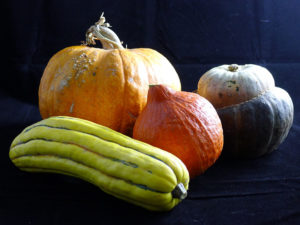 October is the best time of year to shop for great gobs of gourds. Buy plenty so you can have them on hand to enjoy during the cold winter months.
October is the best time of year to shop for great gobs of gourds. Buy plenty so you can have them on hand to enjoy during the cold winter months.
Pumpkins are the most popular of the winter squashes, but most folks use those just for decorating or carving. While you’re shopping, be sure to pick up a few sugar or pie pumpkins to use for cooking, stuffing and baking.
There’s a wonderful world of winter squashes available and now’s the time to stock up for the season. There are at least a dozen kinds of squashes at Nick’s Farm Market to use for decorating and for delicious eating.
Many gardeners grow winter squashes in their vegetable gardens, but most varieties take about twice as long to grow as summer squashes. They also take up more space in the garden, so there’s a limit to the numbers of winter squashes gardeners grow.
Mature winter squashes are perfect for storing for the long term because they’ve been cured to have a tough outer skin. When you shop for a winter squash, look for one that’s colorful, heavy for its size and with a hard rind. Avoid squashes without a stem or those that have blemishes or soft spots because they won’t keep as long when stored in a cool, dry space.
Winter squashes are naturally low in calories, high in fiber and are loaded with vitamins and minerals. Their deep rich yellow and orange colored flesh means they have plenty of beta-carotene, too. Even the seeds are good for roasting and snacking.
Here are eight of the most popular winter squashes and a few ideas for preparing them. Buy at least two or three varieties you’ve never tried before. You might find one you’d like to grow in your vegetable garden next year:
Acorn is one of the most familiar squashes because of its shape and dark green outer skin. Look for one that has a deep yellow grow spot that shows where it was in contact with the soil. Acorn squashes are good for cutting in half, stuffing and baking.
Delicata is the colorful yellow and green squash with an oblong shape. Delicata has a thinner skin than some winter squashes making it easier to slice and roast with olive oil and dried herbs.
Red Kuri has a unusual onion-like shape. These red squashes are a smaller-size, but are dense on the inside. Most chefs prefer to roast these squashes until very tender, remove the flesh and puree for a tasty and beautiful soup. For added flair, scoop the seeds from a small pumpkin to use as an attractive soup tureen.
Blue Hubbard is the large and lumpy blue-gray squash that might scare away some people. The size can be intimidating, but that just means there’s more to love. To prepare, cut in half, place it flesh side down in 1/2 inch of water and bake for 45 minutes to 1 hour at 375 degrees. Scoop out the flesh to use as a side dish, a base for soups and purees, or use it to make “pumpkin” pie.
Spaghetti squashes have a buttery smooth exterior and stringy flesh inside. To use, cut a spaghetti squash in half lengthwise, scoop out the seeds and bake cut side down in a 450-degree oven for 30-40 minutes. Let cool and use a spoon to scrape strands of squash from inside; top with spaghetti sauce.
Sweet Dumpling is as delicious as it sounds. These small-size squashes are a good size for cutting in half and baking. They make cute side dishes when served individually with butter and brown sugar.
Carnival squashes are small speckled squashes that are a cross between Acorn and Sweet Dumpling. They have a slight acorn shape and can be orange, yellow and green with speckles. The flesh is yellow with a mild taste that pairs well with maple syrup.
Butternut squashes are tan with a long neck and bulb-like bottom. For easier cutting through the tough skin, poke a few vent holes in the squash and microwave until slightly soft. Then cut the bottom portion from the neck and slice into rings; then peel. Use butternut squash to make soups, casseroles, muffins and breads.
To prepare the scooped out squash seeds, wash and remove any stringy flesh. Place on a cookie sheet in a single layer, sprinkle with kosher salt or other seasonings and roast in a 400-degree oven for 15-20 minutes or until toasted and lightly browned.


